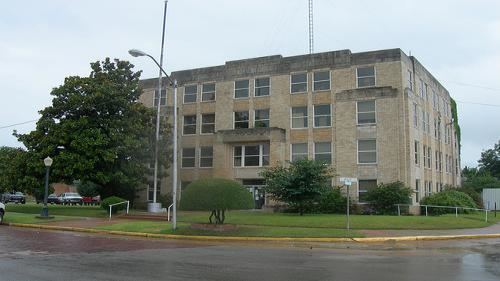Website www.jeffcoinfo.org Area 2,005 km² | Founded 1907 Population 6,432 (2013) Unemployment rate 5.2% (Apr 2015) | |
 | ||
Rivers Red River of the South, Cow Creek, Fleetwood Creek | ||
Jefferson County is a county located in the U.S. state of Oklahoma. As of the 2010 census, the population was 6,472. Its county seat is Waurika. The county was created at statehood and named in honor of President Thomas Jefferson.
Contents
Map of Jefferson County, OK, USA
History
In the 1750s, the Taovaya Indians, a Wichita tribe, established twin villages along the Red River, in Jefferson County and across the river near present-day Spanish Fort, Texas. The village became “a lively emporium where Comanches brought Apache slaves, horses and mules to trade for French packs of powder, balls, knives, and textiles and for Taovaya-grown maize, melons, pumpkins, squash, and tobacco.”
In 1759, in response to the destruction of the San Saba Mission, the Spanish led an expedition against the Taovaya and their allies and attacked the twin villages. The Indians defeated the Spanish army. (See Battle of the Twin Villages) The Taovaya villages were abandoned before 1841 as the Taovaya had been decimated by smallpox and encroachment by other Indians and Anglo-Americans.
In the 1830s, the Choctaw tribe acquired more than two-thirds of the land now covered by Jefferson County, and the closely related Chickasaw tribe began to relocate there. In 1855, the two tribes formally divided and this area became part of the Chickasaw Nation. The western part of the present county became part of the Kiowa-Comanche-Apache Reservation, created by the 1867 Medicine Lodge Treaty. That area was opened to settlement by non-Indians by the Kiowa-Comanche-Apache Opening in 1901.
After the Civil War, the Chisholm Trail, which passed through this area, was heavily used to drive cattle from Texas to markets in Kansas. In 1892, the Chicago, Rock Island and Pacific Railway laid tracks along the trail route. The Enid and Anadarko Railway, sold to the Rock Island in 1903, built a line from Lawton to Waurika. The Wichita Falls and Oklahoma Railroad built the last railroad in the county in 1923, from Texas to Waurika. It went out of business in 1942. A railway line was built from Ardmore to Ringling.
Statehood in 1907 brought about the demise of the Chickasaw government and creation of Jefferson County. At that time the southeast corner of the county extended to Mud Creek including the communities of Belleville and Courtney. In 1924 the southeast corner of the county was realigned to its current boundary. The Oklahoma Constitutional Convention named Ryan as the county seat. An election for the seat was held in 1908 between Ryan, Sugden and Waurika, but none of the towns won a majority. Another election was held in 1912, resulting in Waurika being named as the county seat.
Geography
According to the U.S. Census Bureau, the county has a total area of 774 square miles (2,000 km2), of which 759 square miles (1,970 km2) is land and 15 square miles (39 km2) (2.0%) is water. The county drains into the Red River via Beaver and Mud creeks. Waurika Lake was created in 1971 by damming Beaver Creek in northwestern Jefferson County.
Major highways
Adjacent counties
Demographics
As of the census of 2000, there were 6,818 people, 2,716 households, and 1,863 families residing in the county. The population density was 9 people per square mile (3/km²). There were 3,373 housing units at an average density of 4 per square mile (2/km²). The racial makeup of the county was 87.14% White, 0.69% Black or African American, 5.24% Native American, 1.13% Asian, 0.03% Pacific Islander, 2.86% from other races, and 2.92% from two or more races. 7.01% of the population were Hispanic or Latino of any race.
There were 2,716 households out of which 29.20% had children under the age of 18 living with them, 55.60% were married couples living together, 9.20% had a female householder with no husband present, and 31.40% were non-families. 28.80% of all households were made up of individuals and 15.40% had someone living alone who was 65 years of age or older. The average household size was 2.38 and the average family size was 2.92.
In the county, the population was spread out with 24.00% under the age of 18, 7.20% from 18 to 24, 25.40% from 25 to 44, 23.30% from 45 to 64, and 20.10% who were 65 years of age or older. The median age was 40 years. For every 100 females there were 94.70 males. For every 100 females age 18 and over, there were 93.80 males.
The median income for a household in the county was $23,674, and the median income for a family was $30,563. Males had a median income of $25,195 versus $16,589 for females. The per capita income for the county was $12,899. About 16.30% of families and 19.20% of the population were below the poverty line, including 23.30% of those under age 18 and 18.40% of those age 65 or over.
